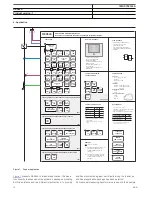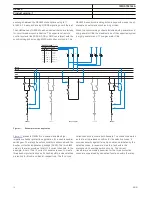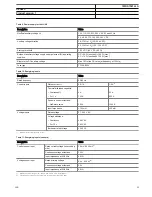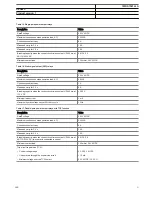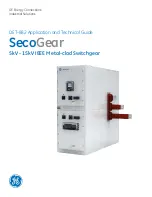
16. Load profile
The load profile recorder stores the historical load data
captured periodically (demand interval). Up to 12 load
quantities can be selected for recording and storing in the
nonvolatile memory. The recordable quantities include
currents, voltages, power and power factor values. The
recording time depends on a settable demand interval
parameter and the amount of quantities selected. The
quantities' type and amount to be recorded are determined in
the application configuration. The recorded quantities are
stored in the COMTRADE format.
17. Trip circuit supervision
The trip circuit supervision continuously monitors the availability
and operability of the trip circuit. It provides open-circuit
monitoring both when the circuit breaker is in closed and in
open position. It also detects loss of circuit-breaker control
voltage.
18. Self-supervision
The relay’s built-in self-supervision system continuously
monitors the state of the relay hardware and the operation of
the relay software. Any fault or malfunction detected is used for
alerting the operator.
A permanent relay fault blocks the protection functions to
prevent incorrect operation.
19. Access control and cybersecurity
Cybersecurity measures are implemented to secure safe
operation of the protection and control functions. The relay
supports these measures with configuration hardening
capabilities, encrypted communication, security event logging
and user access control.
The relay supports role-based user authentication and
authorization with individual user accounts as defined in IEC
62351-8. All user activity is logged as security events to an
audit trail in a nonvolatile memory and sent as messages to the
SysLog server. The nonvolatile memory does not need battery
backup or regular component exchange to maintain the
memory storage. File transfer and Web HMI use communication
encryption protecting the data in transit. Also, the
communication link between the relay configuration tool
PCM600 and the relay is encrypted. All rear communication
ports and optional protocol services can be activated according
to the required system setup.
User accounts can be managed by PCM600 or centrally. A
central account management is an authentication infrastructure
that offers a secure solution for enforcing access control to
relays and other systems within a substation. This incorporates
management of user accounts, roles and certificates and the
distribution of such, a procedure completely transparent to the
user. The central server handling user accounts can be, for
example, SDM600 or an Active Directory (AD) server such as
Windows AD.
The relay supports full Public Key Infrastructure as defined by
IEC 62351-9. With this, the user can ensure that the certificates
used in secured communication are from a user-approved
provider instead of device self-signed certificates.
20. Station communication
Operational information and controls are available through a
wide range of communication protocols including IEC 61850
Edition 2, IEC 61850-9-2 LE, IEC 60870-5-103, Modbus® and
DNP3. The Profibus DPV1 communication protocol is
supported via the protocol converter SPA-ZC 302. Full
communication capabilities, for example, horizontal
communication between the relays, are only enabled by IEC
61850.
The IEC 61850 protocol is a core part of the relay as the
protection and control application is fully based on standard
modelling. The relay supports Edition 2 and Edition 1 versions
of the standard. With Edition 2 support, the relay has the latest
functionality modelling for substation applications and the best
interoperability for modern substations.
The IEC 61850 communication implementation supports
monitoring and control functions. Additionally, parameter
settings, disturbance recordings and fault records can be
accessed using the IEC 61850 protocol. Disturbance
recordings are available to any Ethernet-based application in
the standard COMTRADE file format. The relay supports
simultaneous event reporting to five different clients on the
station bus.
The relay can send binary and analog signals to other devices
using the IEC 61850-8-1 GOOSE (Generic Object Oriented
Substation Event) profile. Binary GOOSE messaging can, for
example, be used for protection and interlocking-based
protection schemes. The relay meets the GOOSE performance
requirements for tripping applications in distribution
substations, as defined by the IEC 61850 standard (class P1,
<3 ms data exchange between the devices). The relay also
supports the sending and receiving of analog values using
GOOSE messaging. Analog GOOSE messaging enables easy
transfer of analog measurement values over the station bus,
thus facilitating, for example, the sending of measurement
values between the relays when controlling transformers
running in parallel.
The relay also supports IEC 61850 process bus concept by
sending sampled values of currents and voltages and by
receiving sampled values of voltages. With this functionality the
galvanic interpanel wiring can be replaced with Ethernet
communication. The analog values are transferred as sampled
values using the IEC 61850-9-2 LE protocol. The intended
application for sampled values are current-based differential
protection functions or sharing the voltage values with the
1MRS759144 A
REX640
Product version: 1
ABB
23
Summary of Contents for RELION REX640
Page 1: ...RELION PROTECTION AND CONTROL REX640 Product Guide...
Page 128: ...128...
Page 129: ......
Page 130: ......
Page 131: ......


